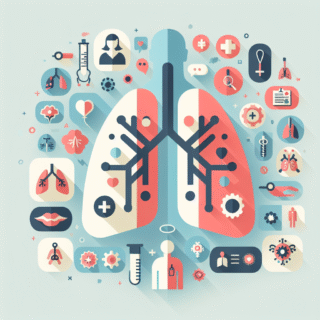
More Allergy, Asthma & Infectious Disease Articles
Different Lung Problems Explained

Breathing is something most of us take for granted until it becomes hard. Many people worry about lungs problems, whether from smoking, infection, or genetics, and understanding what can go wrong helps with prevention and treatment. This article explains common warning signs, outlines different causes, and describes basic management strategies so you can recognize when to seek medical care.
Lung problems: common types and how they differ
There are many types of lung problems, and they vary in severity, onset, and cause. Some affect the airways (bronchi), others target the air sacs (alveoli), and some involve the lung lining or blood vessels. Recognizing the most common lung problems—and how they present—can help you and your healthcare provider reach a timely diagnosis.
Asthma
Asthma is an inflammatory condition of the airways that causes episodes of wheeze, chest tightness, shortness of breath, and cough. Triggers include allergens, exercise, cold air, and respiratory infections. Asthma is managed with inhaled medications (bronchodilators and corticosteroids) and trigger avoidance.
Chronic obstructive pulmonary disease (COPD)
COPD is a progressive disorder that includes chronic bronchitis and emphysema. It commonly occurs in long-term smokers and causes persistent cough, sputum production, and exertional breathlessness. Treatment focuses on smoking cessation, inhaled therapies, pulmonary rehabilitation, and preventing exacerbations.
Pneumonia and respiratory infections
Pneumonia is an infection of the lung tissue that can be caused by bacteria, viruses, or fungi. Symptoms include fever, productive cough, shortness of breath, and chest pain. Vaccination where appropriate (e.g., influenza, pneumococcus) and early treatment are key to reducing complications. Preventing infections in general helps protect lung health; for guidance on avoiding foodborne infections that can affect overall immunity, see this resource on how to avoid Salmonella infections.
Pulmonary embolism
A pulmonary embolism is a blood clot that travels to the lungs and causes sudden shortness of breath, chest pain, and sometimes fainting. It is a medical emergency requiring prompt diagnosis and anticoagulation.
Interstitial lung disease and pulmonary fibrosis
These conditions involve scarring of the lung tissue, causing progressive breathlessness and dry cough. Many different lung problems fall into this category, including idiopathic pulmonary fibrosis and diseases related to autoimmune conditions or occupational exposures. Management aims to slow progression and support breathing.
Lung cancer
Lung cancer may present with cough, weight loss, coughing up blood, or persistent chest pain, though early disease can be silent. Smoking is the main risk factor, but non-smokers can also develop lung cancer. Early detection and specialist care improve outcomes.
Other causes: pleural disease and structural issues
Pneumothorax (collapsed lung), pleural effusion (fluid around the lung), and bronchiectasis (permanent airway dilation) are examples of structural or pleural problems that can cause breathlessness and require specific interventions, from drainage to surgery in some cases.
Recognizing symptoms and when to seek help
Common red flags include sudden or severe breathlessness, chest pain with breathing, high fever with productive cough, coughing up blood, or unexplained weight loss and fatigue. Routine symptoms such as chronic cough, wheeze, or exercise intolerance deserve evaluation, especially if they affect daily life. Your clinician may order chest X-rays, CT scans, lung function tests, or blood work to clarify the diagnosis.
Prevention and self-care
Many types of lung problems are preventable or manageable with lifestyle changes: avoid tobacco smoke, reduce exposure to occupational or environmental pollutants, get recommended vaccinations, maintain a healthy weight, and exercise to keep respiratory muscles strong. Good hand hygiene and infection prevention also reduce the risk of respiratory infections that can damage lung tissue.
For a broader overview of lung disease terminology and causes, a reliable reference is available from an established encyclopedia of medical topics at Lung disease — Wikipedia.
- Regular checkups and early evaluation of persistent respiratory symptoms improve outcomes.
- Quitting smoking and staying current with vaccinations are among the most effective preventive steps.
- Different lung problems require different treatments—diagnosis guides management.
FAQ: What should I know?
Q: How are lung conditions diagnosed?
A: Diagnosis typically uses a combination of medical history, physical exam, imaging (chest X-ray or CT), pulmonary function tests (spirometry), and sometimes blood tests or bronchoscopy. Your symptoms guide which tests are needed.
Q: Can lung damage be reversed?
A: Some conditions, like infections or asthma exacerbations, can improve or resolve with treatment. Chronic changes such as fibrosis or emphysema are often not fully reversible, but treatment can slow progression, relieve symptoms, and improve quality of life.
Other Articles You May Find of Interest...
- Recognizing the Hidden Signs of a Silent Asthma Attack
- Is Dupixent the Key to Managing Your Asthma Effectively?
- Effective Strategies to Overcome PPP Disease and Regain Your Health
- Uncovering the Triggers of Pericarditis and How to Manage Its Impact
- Do Ticks Jump or Climb? Unraveling the Truth About Tick Behavior
- What Does Purulent Mean and How Does It Impact Your Health?
- Common Diseases That Affect Lung Health and Their Impact














